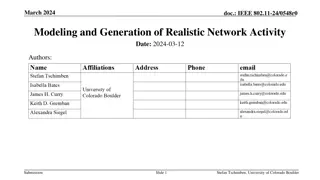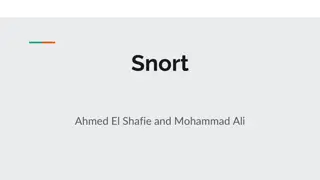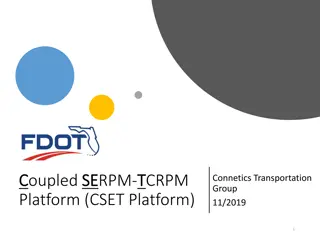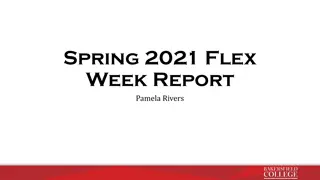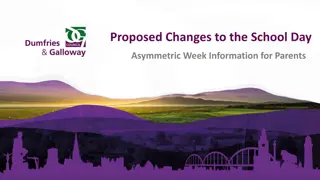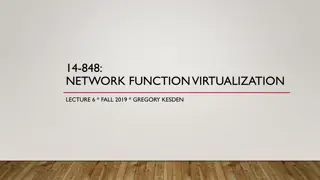
Understanding IPv6 Address Structure and Configuration
Learn about IPv6 address structure, comparison with IPv4, addressing format, and configuration on routers. Discover how IPv6 addresses are divided, the role of network and host bits, conversion from binary to hexadecimal, and configuring routers with IPv6 addresses. Gain insights into the significance of leading zeros, network segmentation, and the representation of IPv6 values using binary, decimal, and hexadecimal formats.
Download Presentation

Please find below an Image/Link to download the presentation.
The content on the website is provided AS IS for your information and personal use only. It may not be sold, licensed, or shared on other websites without obtaining consent from the author. If you encounter any issues during the download, it is possible that the publisher has removed the file from their server.
You are allowed to download the files provided on this website for personal or commercial use, subject to the condition that they are used lawfully. All files are the property of their respective owners.
The content on the website is provided AS IS for your information and personal use only. It may not be sold, licensed, or shared on other websites without obtaining consent from the author.
E N D
Presentation Transcript
IPv6 View video on IPv6 compared to IPv4 https://www.youtube.com/watch?v=vPeOk1f SHMU
IPv6 What is an IPv6 address? Example: Street that is common to all houses on the street. Basically, everyone on that street is a neighbor. I have other neighbors but they might live on a different street. The most common component of the houses on the street is that they all have a unique house number. An IPv6 Address is 128 bits long. A mask of /64 following the IP address means the first 64 bits are the network address (like a street name) on the left side. The second half of the 64 bit address represents the host ID (like a house number) on the right.
IPv6 The bits on the left represent the network address and will have the same common set of bits (street name). The bits on the right represent the house number, which will all be unique numbers on the street. The dividing line for the 128 bit string is called, the mask. Most of the time, the mask is set in the middle of the 128 bit space, the network bits on the left and host bits right.
IPv6 How do we handle a 128 bits number? We break it up the 128 bits into 8 groups of 16, each group separated by a colon (:) delimiter. The 8 groups of 16 bits allows the large number to be more manageable when evaluated. The binary representation is converted into hexadecimal. When determining the value of the hexadecimal, groups of 4 bits (nibble) are utilized.
IPv6 IPv6 value: 2001 : 0DB8 : 8421 8421 8421 8421 : 8421 8421 8421 8421 : 0010 0000 0000 0001 : 0000 1101 1011 1000 2 0 0 1 0 D B 8 Numeric conversion: Decimal representation is base 10. Hexadecimal representation is base 16.
IPv6 Decimal Binary Hexadecimal 0 - 9 1001 0 - 9 10 1010 A 11 1011 B 12 1100 C 13 1101 D 14 1110 E 15 1111 F
IPv6 How to configure the first router (R1): R1# configure terminal R1(config)#interface FastEthernet 0/1 R1(config-if)#description This is the network where Host-A and Host-B reside R1(config-if)#ipv6 address 2001:0DB8:0021:0111:B123:F322:0002:FF21/64 R1(config-if)#Leading zeros, within each of the 8 groups don t need to be typed in. R1(config-if)#The router will recognize the zeros and eliminate them. R1(config-if)#do show ipv6 interface brief
IPv6 FastEthernet0/0 [up/up] Unassigned FastEthernet0/1 [up/up] FE80::C801:CFF:FE3C:6 2001:DB8:21:111:B123:F322:2:FF21 R1(config-if)# Note: Red colored 64 bits street name. All devices on this street are going to have a common street name. Blue colored 64 bits represents the unique host address for R1(interface) at Fa0/1. The FE80::C801:CFF:FE3C:6 represents the link local address. FastEthernet0/1 set to default configuration( R1 interface). R1# default interface Fa0/1
IPv6 What is a Link Local Address? It is 128 bits long. Has a host address portion of the link local address (C801:CFF:FE3C:6) is a Layer 2 address broadcast domain. There are two IPv6 addresses on a single interface.
IPv6 One IP address is a globally reachable and routable address (2001:DB8:21:111) across the Internet. The fe80 prefix is automatically configured by default. This is done by enabling IPv6 on the interfaces prior to configuring the routers (R1 and R2). The link local address is only good on the one segment. R1(config-if)#interface Fa0/0 R1(config-if)#description Connection from R1 to R2 R1(config-if)#! Note: When we configure an IPv6 address, it also enables IPv6 R1(config-if)#! For now, we will just enable IPv6 on the Fa0/0 interface. R1(config-if)# ipv6 enable R1(config-if)#do show ipv6 interface brief
IPv6 R2(config-if)#interface Fa0/0 R2(config-if)#description Connection from R2 to R1 R2(config-if)#! Note: When we configure an IPv6 address, it also enables IPv6 R2(config-if)#! For now, we will just enable IPv6 on Fa0/0 interface. R2(config-if)# ipv6 enable R2(config-if)#do show ipv6 interface brief R1# ping fe80::C802:11FF:FED4:8 R1# show int Fa0/0 inc bia Output: Hardware is i82543 (Livengood), address is CA01.11D4.0008 (bia CA01.11D4.0008)
IPv6 We know the MAC address is only 48 bits long and we need to create a unique 64 bit host ID. Flip the 7thbit, and inject FFFE in the middle of the new EUI-64 host ID. The link local address pulls from the MAC address.
IPv6 Can the link local address by hard coded? Yes R1# config terminal R1(config)# int Fa0/0 R1(config-if)# mac R1(config-if)# mac-address 0000.1111.1111 R1# show ipv6 int brief Output fe80::200:11FF:FE11:1111
The End Thank you for all your hard work and effort this term. Contact me if you have questions and/or concerns. Good luck on the final exam

